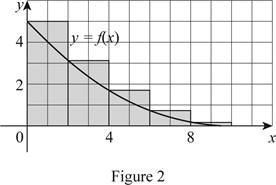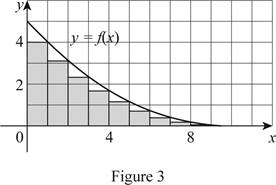
(a)
The lower estimate and upper estimate ofthe area under a graph using five rectangles.
(a)
Answer to Problem 1E
The lower estimate of the area under the graph is 12.
The upper estimate of the area under the graph is 22.
Explanation of Solution
Given information:
Take the curve as
Consider that the region lies between
Consider the number of rectangles as
Use the right end points of the curve as the lower estimate and the left end points of the curve as the upper estimate for decreasing behavior of the curve (f).
The expression to find the lower estimate of the areas of n rectangles
Here, the height of first rectangle is
Draw five rectangles using right endpoints as shown in Figure (1).

Find the width
Here, the upper limit is b, the lower limit is a, and the number of rectangles is n.
Substitute 10 for b, 0 for a and 5 for n in Equation (2).
Refer to Figure (1),
Take the height of the first rectangle’s
Substitute 5 for n, 3.2 for
Therefore, the lower estimate using right endpoints for
Draw five rectangles using left endpoints as shown in Figure (2).

The expression to find the upper estimate of areas of n rectangles
Here, the left endpoint height of the first rectangle is
Refer to Figure (2),
Take the height of the left endpoint
Substitute 5 for n, 5 for
Therefore, the upper estimate using left endpoints for
(b)
The lower estimate and upper estimate of the area using ten rectangles.
(b)
Answer to Problem 1E
The lower estimate of the area using ten rectangles is 14.4.
The upper estimate of the area using ten rectangles is 19.4.
Explanation of Solution
Given information:
Take the curve as
Consider that the region lies between
Consider the number of rectangles to be
Use the right end points of the curve as the lower estimate and the left end points of the curve as the upper estimate for the decreasing behavior of the curve (f).
Draw ten rectangles using right endpoints as shown in Figure (3).

Substitute 10 for b, 0 for a and 10 for n in Equation (2).
Refer to Figure (3),
Take the height of the right endpoint
Substitute 10 for n, 4 for
Therefore, the lower estimate using the right endpoints for
Draw ten rectangles using left endpoints as shown in Figure (4).

The expression to find the upper estimate of the areas of the 10 rectangles
Here, the lower estimate using the right endpoints for
Refer to Figure (4),
Take the height of the left endpoint height
Substitute 14.4 for
Therefore, the upper estimate using the left endpoints for
Chapter 5 Solutions
Single Variable Calculus: Concepts and Contexts, Enhanced Edition
 Calculus: Early TranscendentalsCalculusISBN:9781285741550Author:James StewartPublisher:Cengage Learning
Calculus: Early TranscendentalsCalculusISBN:9781285741550Author:James StewartPublisher:Cengage Learning Thomas' Calculus (14th Edition)CalculusISBN:9780134438986Author:Joel R. Hass, Christopher E. Heil, Maurice D. WeirPublisher:PEARSON
Thomas' Calculus (14th Edition)CalculusISBN:9780134438986Author:Joel R. Hass, Christopher E. Heil, Maurice D. WeirPublisher:PEARSON Calculus: Early Transcendentals (3rd Edition)CalculusISBN:9780134763644Author:William L. Briggs, Lyle Cochran, Bernard Gillett, Eric SchulzPublisher:PEARSON
Calculus: Early Transcendentals (3rd Edition)CalculusISBN:9780134763644Author:William L. Briggs, Lyle Cochran, Bernard Gillett, Eric SchulzPublisher:PEARSON Calculus: Early TranscendentalsCalculusISBN:9781319050740Author:Jon Rogawski, Colin Adams, Robert FranzosaPublisher:W. H. Freeman
Calculus: Early TranscendentalsCalculusISBN:9781319050740Author:Jon Rogawski, Colin Adams, Robert FranzosaPublisher:W. H. Freeman
 Calculus: Early Transcendental FunctionsCalculusISBN:9781337552516Author:Ron Larson, Bruce H. EdwardsPublisher:Cengage Learning
Calculus: Early Transcendental FunctionsCalculusISBN:9781337552516Author:Ron Larson, Bruce H. EdwardsPublisher:Cengage Learning





